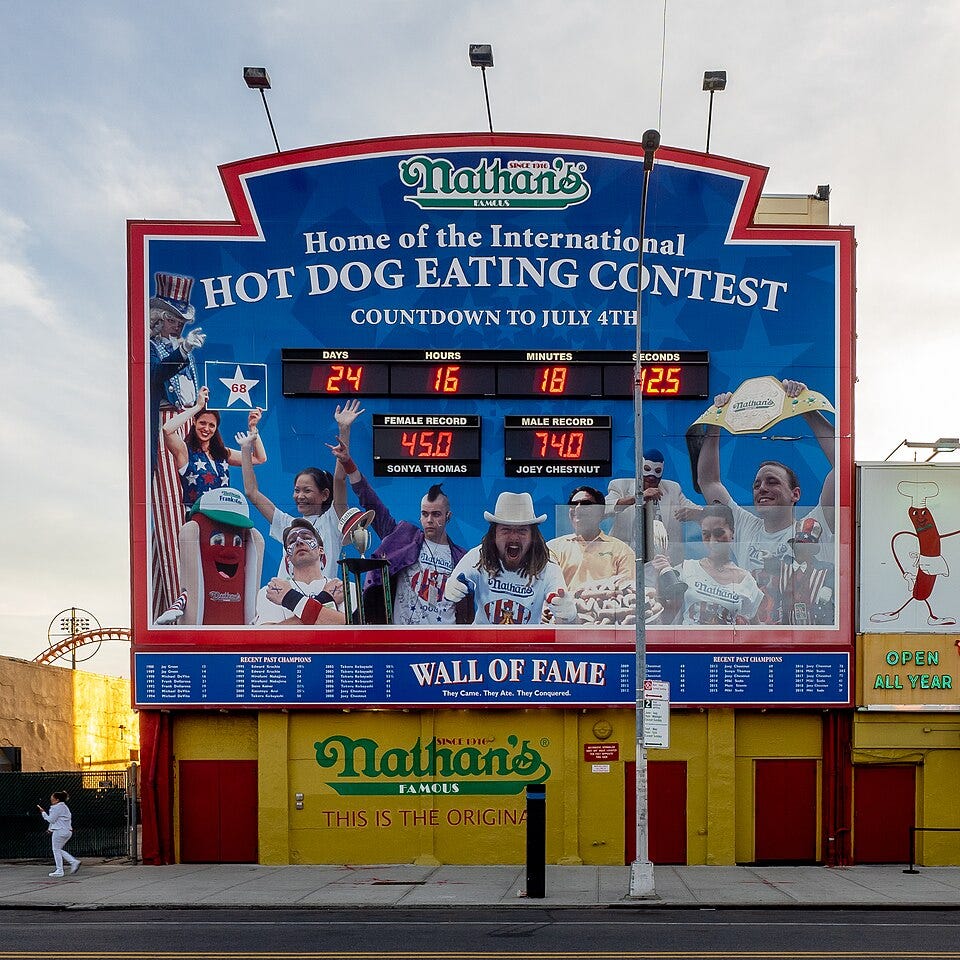Why My Viral Study Went Viral (and My Other Papers Didn’t)
What a viral hot dog study taught me about media attention, science, and storytelling
Author’s Note: This is Part 2 of my previous article, which discusses the background for my viral study on hot dog eating competitions. If you haven’t read that yet, start there!
After the dust settled from the media whirlwind surrounding my hot dog paper, I had a strange realization: This was the most attention any of my research had ever received. By far.
I’ve published dozens of peer-reviewed articles. I’ve written about injury prevention, elite endurance physiology, exercise interventions, even epidemiological critiques. Many of these papers were cited in clinical guidelines or taught in graduate classrooms.
But none of them went viral. None of them landed me on NPR, BBC, CNN, The New York Times, The Guardian, and Science magazine in the same week.
This wasn’t a fluke. It was a lesson.
So I started asking myself: Why this paper? What made this one explode?
1. It was instantly understandable
I could summarize the study in one sentence:
“A researcher modeled the physiological limit of how many hot dogs a human can eat in 10 minutes.”
That’s it. That’s the pitch.
Compare that to something like:
“A nonlinear regression analysis suggests that matrix metalproteinase activity response may contribute to subclinical tendinopathy in endurance athletes.”
You’ve already lost most of the audience.
The hot dog study passed the “cocktail party test.” It was a topic you could drop into conversation with your neighbor, your aunt, or a fifth grader. No technical background needed. People had experience eating hot dogs (whether beef or vegan), and most people have experienced a feeling of eating too much at some point in their lives. Simply put, it was relatable.
That doesn’t mean it was dumbed down. In fact, it relied on advanced statistical modeling (Generalized Extreme Value curves), historical performance trends, and even comparative zoology. But the premise was easy to grasp — and that made it easy to share.
2. It was absurd, but rigorous
People love stories that are both strange and serious. That’s what made this work.
It was undeniably weird: hot dog eating is not a traditional field of academic inquiry, or sport. But I didn’t approach it as a joke. I did real modeling, cited real sources, followed real peer review, and wrote it up with the same care as any of my other publications.
This was key: the fun premise earned attention, but the rigor earned respect.
As one Mayo Clinic human performance expert, anesthesiologist Michael Joyner, MD, told the press, “It’s a great paper. And the best part is, he wrote it with a straight face.” I was both shocked and humbled that Dr. Joyner took the time to review my paper and publicly comment on it.
In a world flooded with clickbait and infotainment, people responded to something that was both entertaining and earnest. They appreciated the idea that science could be playful without being nonsense.
3. It came at the right time
Here’s a detail that can’t be overstated: the story ran in July 2020.
That was four months into the COVID-19 pandemic. The news cycle had been unrelenting — lockdowns, death tolls, mask wars. People were exhausted.
And suddenly, a headline popped up that felt different:
“Scientists Have Finally Calculated How Many Hot Dogs a Person Can Eat at Once.”
It didn’t require doomscrolling. It made people laugh. It gave them something to forward to a friend. It was a relief valve.
Would this study have gone as viral in a different year? Maybe. But I doubt it would have resonated quite as deeply. The timing gave it traction. In some ways, it was a story that needed to happen when it did.
4. It was about something people already cared about (secretly or otherwise)
Many has seen (or at least heard of) the Nathan’s Famous Hot Dog Eating Contest. It’s weirdly iconic. It’s a grotesque spectacle — men and women jamming down as many hot dogs and buns as they can. Scraps of wet food falling out, the competitors chewing with their mouths wide open, trying their best not to vomit (since that is against the rules).
It’s broadcast on ESPN. It happens on the Fourth of July. Joey Chestnut, Takeru Kobayashi, and Miki Sudo have become minor celebrities.

Some found it entertaining, and loved to watch it. Others found it wasteful, and loved to hate it. And many really don’t want to watch people furiously shoveling hot dogs into their bellies, but yet couldn’t look away.
But no one had ever looked at the science behind it — let alone recognize that there was some fascinating biology involved. That’s what made the study novel.
I wasn’t introducing a brand-new world. I was peeling back the curtain on something familiar — and giving people new language to describe it.
That’s a recipe for engagement: connect with something people already know and offer a new lens to look at it.
5. The media recognized the story value — instantly
Here’s something many researchers don’t realize: a study can only go viral if a journalist decides to write about it.
I was lucky to have a previous working relationship with journalist Christie Aschwanden, who saw the potential in the paper right away. She wrote it up for the Times, and that article served as a springboard.
Once it ran in the Times, other outlets quickly followed. Why did journalists latch on? Because the story checked every box:
Strange enough to be intriguing
Legitimate enough to be real news
Timely, funny, and easy to explain
Contained ready-made comparisons to grizzly bears, wolves, and coyotes (what’s not to love?)
As a result, it spread faster than anything I’d ever published.
6. People like to be delighted
This is the simplest answer, and maybe the most important.
People like weird science stories. They like facts they can repeat. They like learning that that humans can outeat bears (but not wolves), or that fat tissue might restrict stomach stretch.
These are facts that make people go, “Huh. That’s wild.”
In an age of polarization, burnout, and mistrust, science that delights might be just as valuable as science that informs. It opens the door. It reminds people that research isn’t just about threats and treatments — it’s about curiosity and wonder, too.
The Lesson: Going Viral Is Not About Importance
Here’s the sobering truth: I’ve done plenty of studies that have a real-world application— about anti-gravity treadmills, ginger supplments, translational pharmacology, and even the connection between traumatic brain injury and cardiorespiratory health and more — but they have barely been noticed outside of academic circles.
And this study?
The one I did mostly to amuse myself, to satisfy a statistical curiosity, and to see what would happen?
It’s now my most popular paper, according to Altmetric. It’s been covered across the globe, and has gotten news coverage every sinlge year since it was published in 2024. It reached tens of millions of people.
Did I plan that? Not exactly. Sort of, I expected it to get lots of social media attention, but not THIS much.
Did I learn from it? Absolutely.
It taught me that science doesn’t spread because it’s important. It spreads because it’s interesting, relatable, and timely — and because someone decided to tell the story well.
If this story is popular, I will add a Part 3, including more insight about the public’s response what this tells us about the value of science itself.





